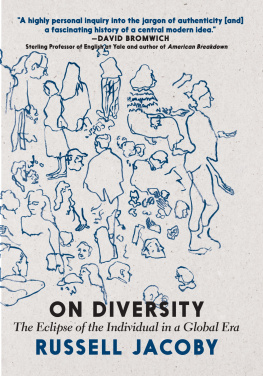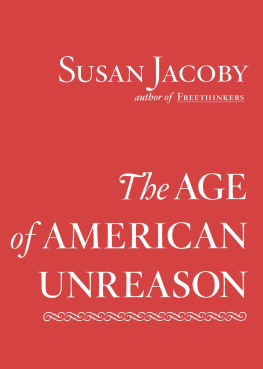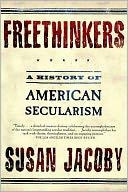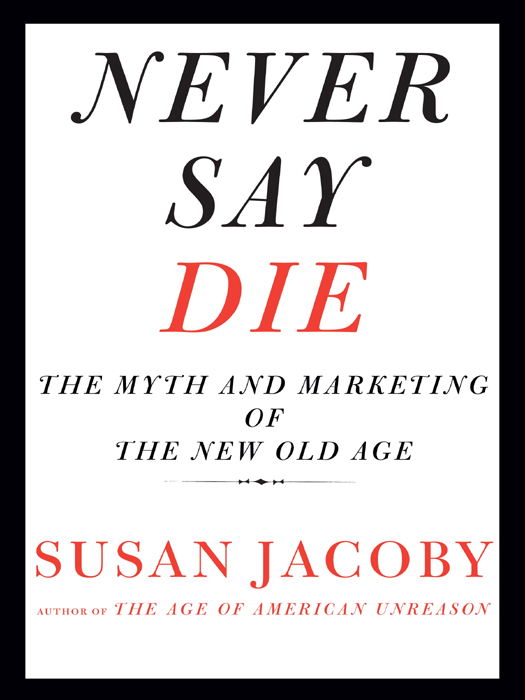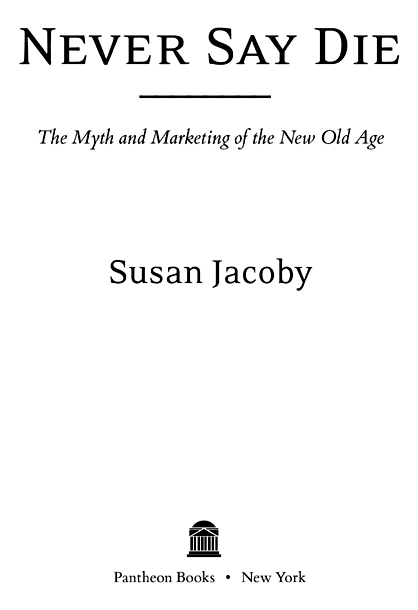ALSO BY SUSAN JACOBY
Alger Hiss and the Battle for History
The Age of American Unreason
Freethinkers: A History of American Secularism
Half-Jew: A Daughters Search for Her Familys Buried Past
Wild Justice: The Evolution of Revenge
The Possible She
Inside Soviet Schools
Moscow Conversations
Copyright 2011 by Susan Jacoby
All rights reserved.
Published in the United States by Pantheon Books, a division of Random House, Inc., New York, and in Canada by Random House of Canada Limited, Toronto.
Pantheon Books and colophon are registered trademarks of Random House, Inc.
Library of Congress Cataloging-in-Publication Data
Jacoby, Susan, [date]
Never say die : the myth and marketing of the new old age / Susan Jacoby.
p. cm.
eISBN: 978-0-307-37960-3
1. Old ageUnited States. 2. AgingUnited States. 3. Older peopleUnited States. I. Title.
HQ1064.U5J324 2010
305.26097309051dc22 2010017123
www.pantheonbooks.com
v3.1
In memory of Dr. Robert N. Butler
19272010
Can you imagine old age? Of course you cant. I didnt. I couldnt. I had no idea what it was like. Not even a false imageno image. And nobody wants anything else. Nobody wants to face any of this before he has to. How is it all going to turn out? Obtuseness is de rigueur.
Philip Roth, The Dying Animal
Contents
Preface
Anyone who has not been buried in a vault for the past two decades is surely aware of the media blitz touting the new old age as a phenomenon that enables people in their sixties, seventies, eighties, nineties, and beyond to enjoy the kind of rich, full, healthy, adventurous, sexy, financially secure lives that their ancestors could never have imagined. Much of this propaganda is aimed at baby boomers now in their late forties, fifties, and early sixties, because marketers are betting that the boomer generation will spend almost anything on products that say Hell no, we wont go! to a traditionally defined old age. I too have read (and occasionally written) optimistic screeds on the joys and advantages of the new old age, also known as young old age, also known as successful aging. But I now regard the relentlessly positive vision promulgated by cheerleaders for the extension of longevity as more of an exhortation, even an ultimatum, than an evidence-based portrait of old age as it is today and is likely to remain for the huge baby boom generation. As the oldest boomers turn sixty-five, it is past time for a more critical and skeptical look at old age as it really is in America today, especially for the old oldthose in their ninth and tenth decades of life. When I told a forty-something colleague that I was writing a book about the myth of young old age, she asked how old I was (a question still considered impolite in most contexts). I told her I was sixty-three. Surely you dont think of that as old? she asked in a horrified tone. Actually, being an American who came of age in the forever young decade, I do not usually think of myself as old. But when I recall how quickly the last two decades, packed with love and work, have sped by, I know how close eighty, or ninety, really isas distinct from whatever subjective notions I cherish about my own youthfulness. Old, in America, always seems to be a decade or preferably two decades older than ones own age. The difference between forty and sixty is that, at sixty, the imaginative leap to old old age is not only possible but inescapable.
The idea that there is a new kind of old age, experienced in a radically different way from old age throughout history, is integral to the marketing of longevity. For who would want to live to be one hundred if, as individuals and as a society, we accepted or even suspected that the new old age, after a certain point, encompasses most of the vicissitudes of old-fashioned old age? There is a considerable amount of truth in the assertion that many old people todayif they are in sound financial shape, if they are in reasonably good health, and if they possess functioning brainscan explore an array of possibilities that did not exist even a generation ago. If is the most important word in the preceding sentence. The idea that we can control the future by aggressively focusing on and taking care of ourselves is an article of faith for baby boomers. Yet in many instances, successful agingor the outward appearance of successful agingmeans only that a person has managed to put on a happy face for the rest of the world; present an image of vigor and physical well-being even when bones are aching; smile even though a heart may be breaking with loss; do everything possible to conceal memory lapses; demonstrate a consistent willingness to try anything new; and scoff (with just the right, light touch of humor) at those misguided contemporaries who refuse to live in the present.
Heres what one cannot do and be considered a person who is aging successfully: complain about health problems to anyone younger; weep openly for a friend or lover who has been dead more than a month or two; admit to depression or loneliness; express nostalgia for the past (either personal or historical); or voice any fear of future dependencywhether because of poor physical health, poor finances, or the worst scourge of advanced old age, Alzheimers disease. American society also looks with suspicion on old people who demand to be left alone to deal with aging in their own way: one must look neither too needy for companionship nor too content with solitude to be considered a role model for healthy aging rather than a discontented geezer or crone. Successful aging awards are conferred only on those who have managed (often as much by biological good luck as effort) to avoid, or convince others that they have avoided, the arduous uphill fight that eventually consumes all who live too long to retain control over either the mundane or the important decisions of everyday life. Its great to be oldas long as one does not manifest too many of the typical problems of advanced age. The reality evaded by propagandists for the new old age is that we all are capable of aging successfullyuntil we arent.
I hope that this book about the genuine battles of growing old will provide support for all who draw their strength and courage from reality, however daunting that reality may be, rather than from platitudes about defying old age. This commonly used phrase in the annals of the so-called new old age fills me with rage, because the proximity of old age to death is not only undefiable but undeniable. Anger, by the way, is another emotion considered inappropriate in the old; the dubious notion of the wisdom of old age rests on the belief that elders can, and should, transcend the passions, vaulting ambition, and competitiveness of their younger adult lives and arrive at some sort of peace that passeth all understanding.
The capacity to negotiate between the past and the present, not transcendence of the emotions and desires that have made us who we are, is the proper definition of aging with dignity. The great Russian-born dancer Mikhail Baryshnikov, who once seemed to float above stage and earth as the preeminent male classical ballet star of his generation, bravely called himself a dancing fossil on the Today show. Having just turned sixty, he described the role of the older dancer as that of a mediator between your memories and your [current] abilities as a human skeleton. This unromantic description of successful aging is applicable not only to natures blessed exceptions, who figure so prominently in most prescriptions for age-defying behavior, but to anyone whose intense desire for meaningful experience remains undiminished by a realistic recognition of times indelible, deepening imprint. The search for new, earthbound ways to express lifelong passionsnot to transcend them in some mythical metamorphosis that seems more akin to a heavenly ascensiondemands the most arduous efforts from and offers the most rich rewards for every aging human skeleton. Anyone who has outlived his or her passions has lived too long. Wordsworth got it exactly right, at the tender age of thirty-seven, in his Ode: Intimations of Immortality from Recollections of Early Childhood:





